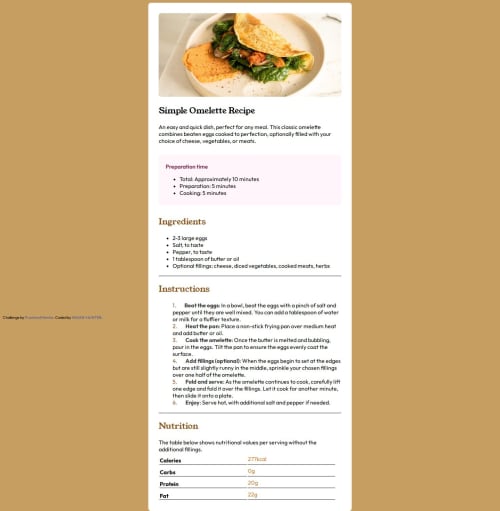
Solution retrospective
using tables and design tools
What challenges did you encounter, and how did you overcome them?design and tables tag
What specific areas of your project would you like help with?solutions for designs varieties
Please log in to post a comment
Log in with GitHubCommunity feedback
- P@dedo-dev
Hi @MAIAN-HUNTER, I reviewed your repository and I have some suggestions for you:
- Adopt mobile-first approach, is a good way to style the
html; - Try to start to use a modern approach with the
cssby using Logical properties example: -margin-left = margin-inline-start; -margin-bottom = margin-block-end; - Check out this article about Logical properties; - To follow the design you need to remove the
paddingon your.container, you can add it by using@mediaor@containerquery, I used the second one, or maybe the fluid spacing; - You need to set all the headings bigger than now;
- Don't use
strongif your goal is only to highlight text, instead use theborspanto achieve that. Read this article to discover why; - To make a divider use the semantic
hror adivwith class.dividerfor example, the last one was my solution, instead of settingpadding-topto theh2; - Remove the default
paddingfromulandol, and to style the bullet points use the same trick that you use on theliforol(they should be bold), and play with::beforepseudo-element, this is how I did all the marker for the list; hint:left: some rem - To style the
borderof thetableyou can usetable {border-collapse: collapse;}, with thiscsstheborderlooks like a single line; - In my solution I used only
trandtdto make the table, maybe this doesn't matter, but you need to highlight the right column of the table,thhasfont-weight: bold;as default on it; - Fix the
footertag and position, on mobile view it overlaps the layout and on large screen, it sits on the left of the card;
Hoping you find this helpful ✌️
Keep learning 📖 Keep coding 💻Marked as helpful - Adopt mobile-first approach, is a good way to style the
Join our Discord community
Join thousands of Frontend Mentor community members taking the challenges, sharing resources, helping each other, and chatting about all things front-end!
Join our Discord